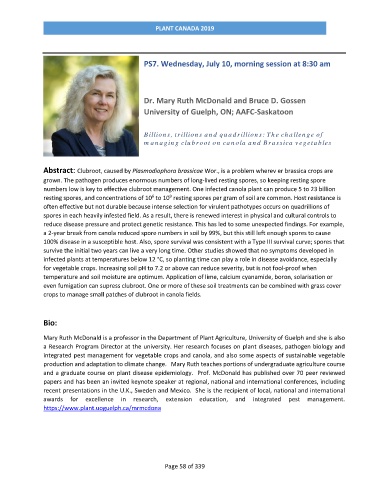Page 60 - PC2019 Program & Proceedings
P. 60
PLANT CANADA 2019
PS7. Wednesday, July 10, morning session at 8:30 am
Dr. Mary Ruth McDonald and Bruce D. Gossen
University of Guelph, ON; AAFC-Saskatoon
Billions, trillions and quadrillions: The challenge of
managing clubroot on canola and Brassica vegetables
Abstract: Clubroot, caused by Plasmodiophora brassicae Wor., is a problem wherev er brassica crops are
grown. The pathogen produces enormous numbers of long-lived resting spores, so keeping resting spore
numbers low is key to effective clubroot management. One infected canola plant can produce 5 to 23 billion
6
resting spores, and concentrations of 10 to 10 resting spores per gram of soil are common. Host resistance is
9
often effective but not durable because intense selection for virulent pathotypes occurs on quadrillions of
spores in each heavily infested field. As a result, there is renewed interest in physical and cultural controls to
reduce disease pressure and protect genetic resistance. This has led to some unexpected findings. For example,
a 2-year break from canola reduced spore numbers in soil by 99%, but this still left enough spores to cause
100% disease in a susceptible host. Also, spore survival was consistent with a Type III survival curve; spores that
survive the initial two years can live a very long time. Other studies showed that no symptoms developed in
infected plants at temperatures below 12 °C, so planting time can play a role in disease avoidance, especially
for vegetable crops. Increasing soil pH to 7.2 or above can reduce severity, but is not fool-proof when
temperature and soil moisture are optimum. Application of lime, calcium cyanamide, boron, solarisation or
even fumigation can supress clubroot. One or more of these soil treatments can be combined with grass cover
crops to manage small patches of clubroot in canola fields.
Bio:
Mary Ruth McDonald is a professor in the Department of Plant Agriculture, University of Guelph and she is also
a Research Program Director at the university. Her research focuses on plant diseases, pathogen biology and
integrated pest management for vegetable crops and canola, and also some aspects of sustainable vegetable
production and adaptation to climate change. Mary Ruth teaches portions of undergraduate agriculture course
and a graduate course on plant disease epidemiology. Prof. McDonald has published over 70 peer reviewed
papers and has been an invited keynote speaker at regional, national and international conferences, including
recent presentations in the U.K., Sweden and Mexico. She is the recipient of local, national and international
awards for excellence in research, extension education, and integrated pest management.
https://www.plant.uoguelph.ca/mrmcdona
Page 58 of 339

